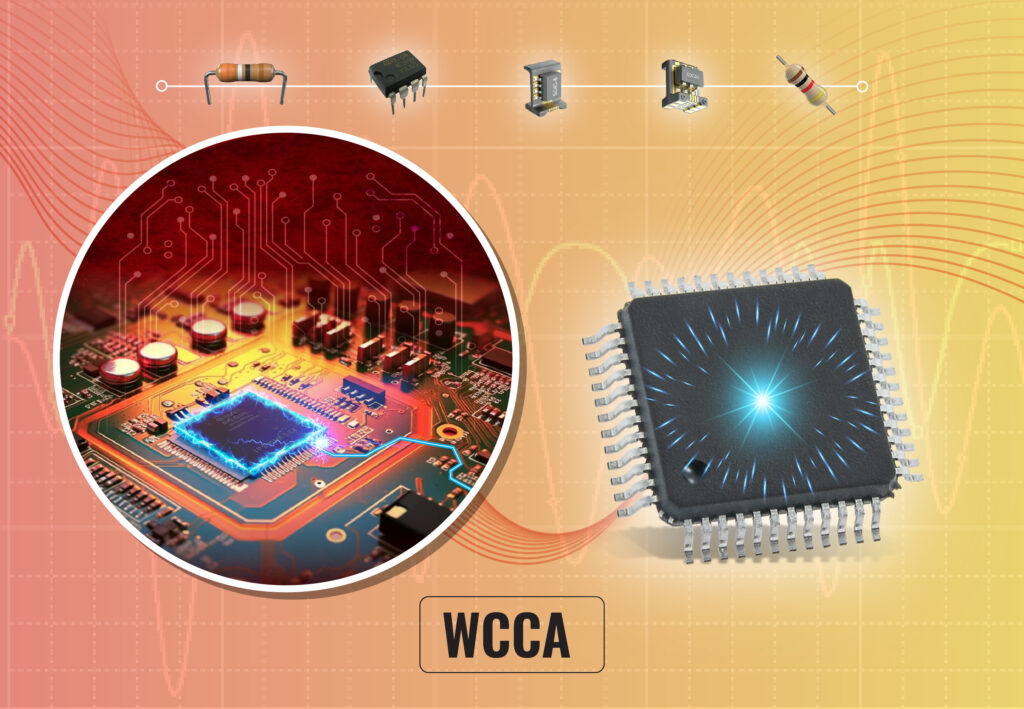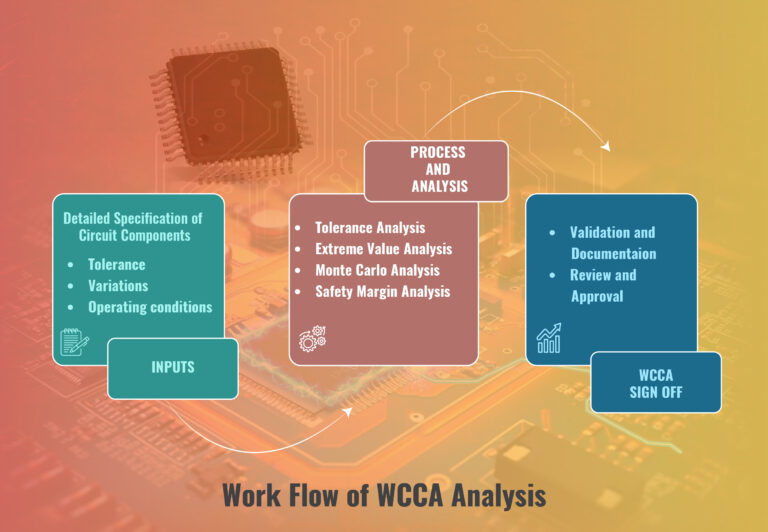Expert Worst-Case Circuit Analysis Solutions
Worst Case Circuit Analysis is not an after-the-fact exercise but a cost-effective integral part of the design process.
A Worst-Case Circuit Analysis (WCCA) involves a detailed quantitative evaluation of equipment performance, taking into consideration factors such as manufacturing variations, environmental conditions, and aging effects. Beyond circuit analysis, WCCA typically encompasses stress and derating analysis, Failure Modes and Effects Criticality Analysis (FMECA), and Mean Time Between Failure (MTBF) Analysis. This comprehensive approach ensures a thorough understanding of equipment behavior under various scenarios, enhancing reliability and performance assessments.
The working requirements encompass external electrical inputs, considering factors like component grade level, inter-component relationships, and component aging-induced drift. The result of a WCCA provides an estimation of actual part stresses against rated part parameters. This aids in determining adequate part stress derating to fulfill design requirements. GigHz conducts WCCA comprehensively for all circuitry that requires safety.


WCCA is not an after-the-fact exercise but a cost-effective integral part of the design process.
A Worst-Case Circuit Analysis (WCCA) involves a detailed quantitative evaluation of equipment performance, taking into consideration factors such as manufacturing variations, environmental conditions, and aging effects. Beyond circuit analysis, WCCA typically encompasses stress and derating analysis, Failure Modes and Effects Criticality Analysis (FMECA), and Mean Time Between Failure (MTBF) Analysis. This comprehensive approach ensures a thorough understanding of equipment behavior under various scenarios, enhancing reliability and performance assessments.
The working requirements encompass external electrical inputs, considering factors like component grade level, inter-component relationships, and component aging-induced drift. The result of a WCCA provides an estimation of actual part stresses against rated part parameters. This aids in determining adequate part stress derating to fulfill design requirements. GigHz conducts WCCA comprehensively for all circuitry that requires safety.

Why Do We Need Worst-Case Analysis in Embedded Systems?
Reliability Assurance
Worst-case circuit analysis (WCCA) is essential for embedded systems to guarantee reliability in challenging conditions. By evaluating worst-case scenarios, engineers can design circuits that demonstrate consistent performance, even in adverse situations.Safety Compliance
In safety-critical embedded systems, adherence to worst-case conditions is often a regulatory requirement. WCCA helps identify potential hazards and ensures that the system operates safely under all circumstances.Performance Guarantees
In industries demanding consistent and predictable circuit performance, like medical devices or aerospace systems, worst-case analysis is indispensable. It aids in setting performance guarantees and meeting rigorous requirements.Tolerance Stack-Up
In embedded systems, component tolerances of each model can accumulate, resulting in performance variations. WCCA enables designers to consider the cumulative effects of these tolerances, preventing unforeseen issues.Power Consumption
In battery-powered embedded systems, worst-case analysis is crucial for estimating maximum power consumption. This is essential for optimizing battery life and ensuring that the device operates within specified power limits.Signal Integrity
Signal Integrity Analysis is crucial in embedded systems to prevent signal distortion or crosstalk. Worst-case scenarios help in designing circuits that maintain signal integrity under the most adverse conditions.Fault Tolerance
In safety-critical applications, the ability of the system to tolerate faults is paramount. Worst-case analysis aids in identifying potential failure points and designing fault-tolerant mechanisms to enhance system robustness.Cost Reduction
Performing a Worst-Case Circuit Analysis (WCCA) typically represents less than 1% of the overall program cost. However, the absence of WCCA could result in costs equivalent to 100% of the program expenses.Identifying worst-case scenarios early in the design phase can lead to a more efficient use of resources. It helps prevent overdesign and unnecessary costs by focusing efforts on addressing the critical aspects that impact system performance under extreme conditions.Benefits of Our Worst Case Circuit Analysis Services
Enhancing Product Reliability
WCCA (Worst Case Circuit Analysis) plays a critical role in enhancing product reliability. Our approach uses robust mathematical models, simulation-based methods, and hardware correlation to establish part stress margins and define the End-of-Life/Beginning-of-Life (EOL/BOL) operating specifications. The failure of even a single over-stressed component can lead to significant financial losses. Our comprehensive WCCA acts as a preventive measure against such risks, ensuring your products meet high standards of reliability.
Crosstalk Analysis
At GigHz, our analysis and simulation services focus on identifying and quantifying crosstalk—unwanted electromagnetic interference between adjacent conductors or components. We consider factors such as signal frequency, conductor distance, and circuit layout to reduce interference and improve signal integrity, which is essential for electronics and telecommunications performance.
Stress and Derating Analysis
Our stress and derating analysis helps reduce maximum rated values to enhance reliability and prevent premature failure. This process is a vital part of worst case circuit analysis, ensuring circuits can endure harsh conditions while meeting safety and reliability standards.By integrating WCCA analysis early in the design phase, we help ensure your systems remain stable and durable over time..
Provide Acceptance Test Procedure (ATP) Limits
In WCCA, we establish ATP Limits, which are crucial for assessing whether a circuit meets reliability, safety, and functionality criteria. Our testing validates the circuit’s ability to perform within acceptable parameters under extreme conditions. Successfully passing ATP Limits demonstrates a circuit’s robustness in real-world scenarios, providing you with confidence in its design.
Monte Carlo Analysis (MCA)
GigHz delivers the most realistic estimate of worst-case performance through Monte Carlo Analysis (MCA), a powerful tool for risk assessment. While the process can be complex and time-consuming, it offers invaluable insights into variability, allowing us to predict the likelihood of performance issues with high accuracy.
Extreme Value Analysis (EVA)
We use EVA to ensure that products remain operational throughout their entire life cycle, even under the toughest conditions. By evaluating the most extreme combinations of expected conditions, we provide a safety net for your designs, ensuring they continue to perform optimally in the most challenging environments.
Root-Sum-Squared (RSS)
GigHz employs the Root-Sum-Squared (RSS) method for a more realistic estimation of worst-case performance. By factoring in variations across components, we provide a more accurate picture of the expected failure rates. While the RSS method is widely used, it does come with certain assumptions that may not apply to every circuit, so it’s important to consider this when analyzing results.
Ready To Improve Your Tolerance Analysis?
Our analysis services help optimize functional criteria for static and kinematic systems. We offer
- Monte Carlo, worst case circuit analysis, or RSS tolerance methods
- Dimensional, geometric, and physical variation analysis
- The ability to evaluate individual or combined tolerances across multiple components
Our Worst Case Circuit Analysis in Embedded Systems
While not every facet of a design necessitates Worst-Case Circuit Analysis (WCCA), it is strongly recommended for components and circuits crucial to project safety and financial viability. WCCA identifies areas requiring enhancement or redesign before a product can undergo safety tests and production.
Analyzing Out-of-Tolerance Limits
GigHz specializes in assessing out-of-tolerance limits, revealing instances where a part continues to function initially but may experience breakdowns over time. This may result in the part operating within acceptable parameters initially but experiencing degradation or failure beyond the specified tolerances as time progresses. GigHz specializes in assessing such scenarios and addressing issues related to long-term performance and reliability.
Analyzing Catastrophic Failures
In the context of Worst Case Circuit Analysis (WCCA), “catastrophic failures” refer to situations where a component or the entire circuit does not work properly and fails to meet its intended functionality. These failures are significant and can have severe consequences, potentially leading to safety hazards, financial losses, or other critical issues. GigHz specializes in assessing and analyzing catastrophic failures during the WCCA process to identify potential risks and improve the design to ensure reliable performance.
How We Work at GigHz
Worst-Case Circuit Analysis (WCCA) at GigHz aligns with a fundamental engineering principle – always plan for the worst-case scenario. By conducting WCCA, we systematically assess designs, identifying potential risks before advancing to further stages of product development or market release. Our approach involves testing circuits under extreme conditions, tailored to the specific worst-case scenarios for each device.For instance, we may evaluate a plane or drone in high temperatures or stormy weather, or subject a new product to testing with external stressors like humidity or radiation. This proactive analysis ensures preparedness for challenging situations.The specific goal is to confirm that the design exhibits robustness, ensuring an operational performance that aligns with the system performance specifications throughout the design life, even under the most challenging conditions and variations, including initial conditions, aging, radiation, temperature, etc.GigHz utilizes our expertise in circuit parts and simulation tools to comprehend the functionality of these components. This enables us to construct precise models of these parts, incorporating comprehensive details about their behavior and the extent of variation from their typical performance.Frequently Asked Questions
Q: What are the Benefits of using Worst Case Circuit Analysis in Embedded Systems?
A: Worst Case Circuit Analysis (WCCA) in embedded systems provides a comprehensive approach to assessing and ensuring the reliability, safety, and functionality of electronic circuits under extreme conditions. WCCA is instrumental in analyzing static or kinematic systems, preventing unexpected issues arising from component tolerances, and estimating maximum power consumption in battery-powered devices.
Q: What is the Worst Case Calculation?
A: A worst-case analysis involves evaluating the functional performance of a circuit, taking into consideration various tolerances. These include factors such as Beginning of Life (BOL), environmental conditions (temperature), aging effects leading to End of Life (EOL), and, in the context of space applications, radiation tolerances.
Q: How can GigHz-EaaS assist in Worst Case Analysis Services for startups to Enterprise Companies?
A: As an engineering services company, GigHz can provide the following reverse engineering benefits:
Cost Reduction – Our engineers can analyze processes to let you identify weaknesses and areas where the resources are being wasted in the current process.
Risk Mitigation – Leveraging our extensive experience, we adeptly identify potential issues in the early stages and propose design or component changes to proactively mitigate risks.
Performance Guarantees – In applications where consistent and predictable performance is crucial, such as in medical devices or aerospace systems, GigHz WCCA establishes performance guarantees and ensures compliance with stringent requirements.
Q: What are the common mistakes in WCCA?
A: Some common WCCA mistakes include failing to consider operating conditions, failing to consider component tolerances, and underestimating the impact of part variability.
Q: Why is it important to perform a circuit analysis?
A: A circuit analysis is essential for ensuring that a design will work reliably under all specified operating conditions. It helps in the identification of potential failure modes and the verification that the design meets performance requirements.
Q: What is meant by exploring topics in WCCA?
A: Exploring topics in WCCA entails delving into various aspects such as circuit design, derating components, considering tolerance databases, and evaluating the impact of operating conditions on the performance of the design.
Q: How can I support the WCCA process?
A: You can help the WCCA process by providing accurate test data, collaborating with suppliers to obtain component information, and using analytical and calculation tools.
Q: Is Worst Case Circuit Analysis applicable to IoT devices?
A: Yes, worst case circuit analysis (WCCA) is essential for IoT devices. It accounts for parameter variability and extreme operating conditions, helping ensure reliable performance. WCCA analysis mitigates risk and improves device stability in real-world environments.
Q: What is the role of tolerance stack-up in WCCA?
A: Tolerance stack-up analysis is required in WCCA to account for cumulative variations in component dimensions and ensure that the performance of the design is not compromised due to assembly variations.
